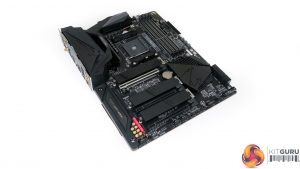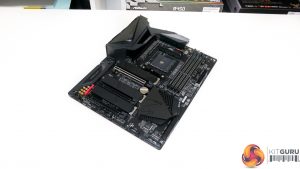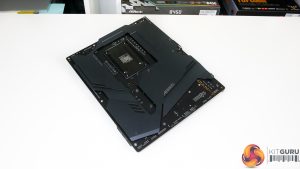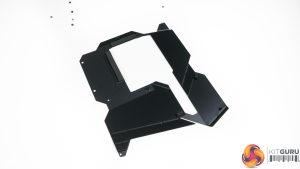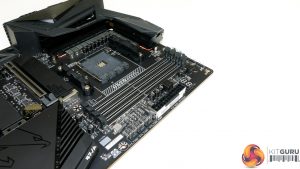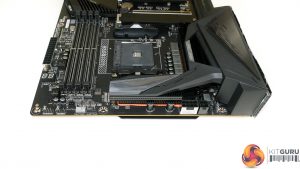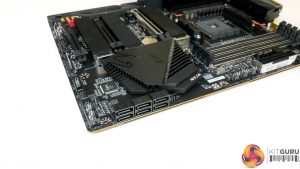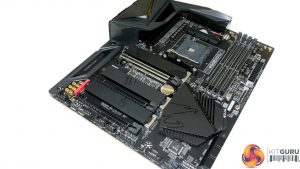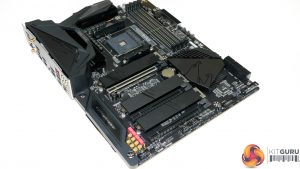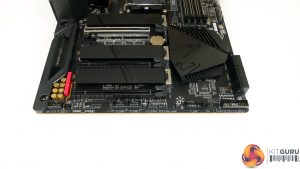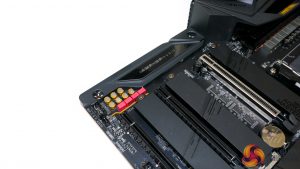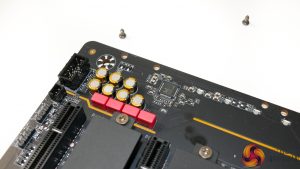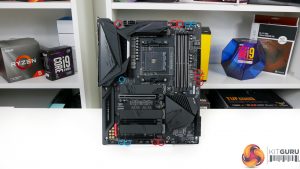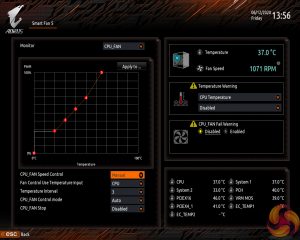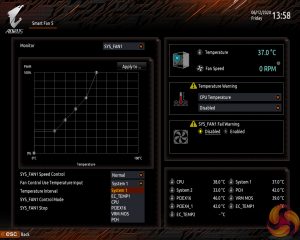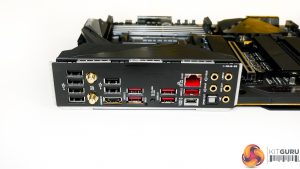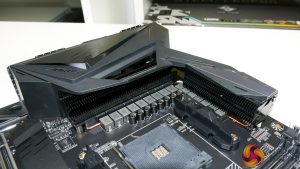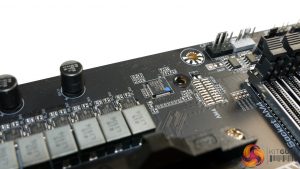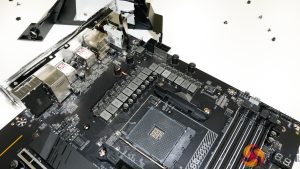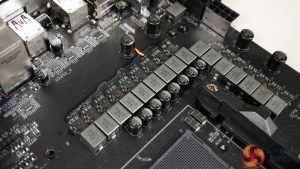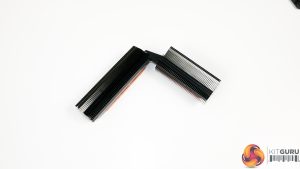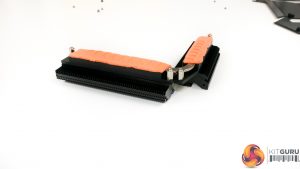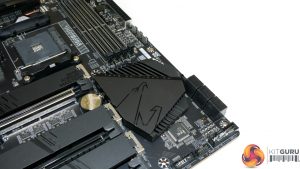Gigabyte ships a healthy bundle with the B550 Aorus Master. Buyers are treated to RGB extension cables, four SATA cables, two thermal sensor cables, a front panel cable quick connector block, the noise sensor cable, and a couple of Velcro cable wraps. The large, stand-alone WiFi antenna also forms part of the bundle.
Primarily black and dark grey in styling, the Gigabyte B550 Aorus Master is an aesthetically pleasing motherboard and fits the usual AORUS theme.
RGB glow is subtle and not over the top, which is a good thing as there are ample headers to increase and control the lighting quantity as you see fit.
The large rear IO cover and integrated IO shield add to the feeling of premium design.
Moving around to the backside, we see a large metal backplate mounted to the 6-layer PCB. The backplate adds clear rigidity to the motherboard, aiding with mechanical load distribution when hanging a heavy CPU cooler from the socket.
There's also a cooling benefit from the backplate, as thermal pads make contact with the PCB directly beneath the MOSFET area.
Four dual-latch DIMM slots house up to 128GB of DDR4 memory. These DIMM slots are steel reinforced to minimise PCB flex. Gigabyte highlights support for some 5GHz+ RAM kits according to the QVL.
I am very pleased to see the 2-digit debug LED and four individual POST LEDs mounted near the 24-pin connector. Those two sets of features are handy during troubleshooting times.
The trio of fan headers in this location is also excellent from a cable management perspective. However, I am disappointed to see a complete lack of onboard power/reset/clear CMOS buttons on a premium motherboard at this price point. Some onboard voltage monitoring points would have been welcomed, too, but they are perhaps an unnecessary luxury given the target audience.
8+4-pin CPU power connectors will provide plenty of juice to an AM4 chip. The connectors are tucked away nicely for easier cable management.
Gigabyte uses an excellent location for three top-edge fan connectors. They are all 4-pin and one is tucked away near the power connectors, making its trailing cable easy to hide. The pair of RGB headers are also in a smart location with a clear and easy route for hiding the cables.
Gigabyte's noise sensor header is mounted up in the top-right corner. Thankfully, the header and supplied cable do not actually listen or interpret any audio. Instead, the sensor detects pressure – which is tied to fan airflow and speed – and makes adjustments based on that data. In turn, this should allow the data to be used to reduce the fan speed and therefore noise levels when the temperature control curve permits.
Six SATA ports are included, all of which operate from the B550 chipset. SATA ports 4 and 5 share bandwidth with the bottom PCIe slot, so these should be used last of all. There is also a Thunderbolt AIC header if you want to upgrade to TB3.
No internal USB-C header is highly disappointing, especially for this price point. Do we really need so many ports allocated to the back panel and zero for a case front IO? This decision alone is one that will be a deal-breaker to many potential buyers. I do not know why Gigabyte made this move.
You get triple M.2 slots with metal heatsinks and thermal pads on the B550 Aorus Master. Slot spacing is ideal for an ATX board as there’s no right-side room away from the GPU. The second slot is not directly under a 2 or 2.5-slot GPU so it should have slightly fewer cooling worries.
The M.2 slots are all Gen 4 by design as they all come from the CPU PCIe Gen 4 lanes. The top M.2 slot uses the dedicated M.2 PCIe x4 connection to the CPU, while the second and third slots steal their bandwidth from the PCIe x16 graphics card slot.
Use M.2 slot 2 or slot 3 and the GPU drops to x8, even when using Gen 3 SSDs. This is genius for users who want plenty of high bandwidth storage – including RAID configurations – and will accept the compromise of a drop to x8 on the GPU. The other key benefit of this approach is that the SSDs bypass the PCIe 3.0 x4 CPU-to-chipset link and therefore there is less bottleneck potential.
The top PCIe slot runs with PCIe Gen 4 lanes direct from the CPU. It will run at x16 if M.2 slot 2 or slot 3 are not populated but drops to x8 with either or both of those populated. X16 vs x8 for the graphics card is perhaps not a huge issue, but that depends on use cases and individual preference.
The second full-length slot is spaced away from the main slot which allows for triple-wide GPU coolers. This second slot runs at PCIe Gen 3 x4 bandwidth from the B550 chipset and does not share any lanes, which is good. The bottom slot is also up to PCIe Gen 3 x4 from the chipset. It runs at x4 natively, or x2 when SATA ports 4 or 5 are used.
Both of these slots are ideal for use with M.2 SSDs via AIC adapters if you want to retain full x16 bandwidth for your graphics card. With that said, the B550 chipset has a PCIe 3.0 x4 link to the AM4 CPU, so you must bear the bottleneck potential in mind when deciding on your PCIe/M.2 SSD routing preference.
There is no real support for multi-GPU configurations such as CrossFire/SLI as you can’t or don’t want to run at x4 from the chipset.
The PCIe design is clearly very good for multiple high-bandwidth cards such as high-speed NICs or video capture cards. I would argue that this is the perfect slot layout for this calibre of motherboard – you get triple-slot spacing for the GPU, dual-slot capability for the dedicated x4 slot, and a single-slot x4/x2 card in the bottom.
We get the usual set of bottom edge connectors. Dual USB 2.0 headers is ideal for smart AIO cooler users. The single 5Gbps USB 3.0 front panel header is down the bottom which is not ideal for users with larger cases or shorter cables.
Two fan headers and two RGB headers are in locations that make cable management very easy. And one of the temperature sensor headers is also located along the bottom edge.
Gigabyte’s AMP-UP audio design is based around the Realtek ALC1220-VB audio codec. Nichicon and WIMA audio caps are used for signal filtering, and dedicated PCB tracks aim to minimise EMI.
Two RGB headers are located in the top-right section and two more along the bottom edge. Gigabyte goes one step further by adding a single 4-pin RGB header near the CPU socket and this is an ideal location for use with AIO pump units.
An ITE IT8688E chipset is used for system monitoring and basic management duties. Dual soldered 256Mb (32MB) BIOS chips is an ideal solution for redundancy and resiliency.
Gigabyte deploys a total of eight 4-pin fan headers distributed very smartly around the motherboard. Six are within easy reach of the CPU socket.
You get good sensor input data for control in the Gigabyte UEFI Smart Fan 5 section. Excellent speed curve control ability is available, as is common for recent Gigabyte motherboards.
In our opinion, Gigabyte's Smart Fan 5 is the best fan control implementation on the market.
The rear IO is flooded with USB ports – 12 in total. Six USB 2.0 ports are good for peripherals, but there are arguably more than necessary. You get six more 10Gbps USB 3.2 Gen 2 ports, one of which is Type-C. The one Type-C and one Type-A run from the B550 chipset and the other four are fed from the Ryzen CPU.
We feel that it is unjustifiable to have this many rear 10Gbps USB ports without an internal USB Type-C header. This is a bad design choice as Gigabyte could have easily redeployed two USB ports to be used with an internal Type-C header.
2.5GbE is excellent to see and this comes from the Realtek RTL8125BG NIC. You also get high-speed wireless in the form of an Intel WiFi 6 AX200 adapter and Bluetooth support.
HDMI 2.1 is available for use with APUs. There is no DisplayPort at all which is disappointing for APU users wanting to run an older high-resolution monitor or perhaps dual screens.
The BIOS Q-Flash Plus button and a dedicated USB port are mounted on the rear IO. Gigabyte does not provide a clear CMOS button and this is disappointing for a motherboard in this market segment.
Gigabyte's power delivery solution on the B550 Aorus Master is a beast. The 16-phase power delivery solution is deployed as a 14+2 configuration for the CPU+SoC.
The Infineon XDPE132G5C PWM controller is a true 16-phase digital controller. This is arguably the best PWM controller on the market and does not use phase doublers or a parallel implementation. This is the same controller as is used on the higher-end X570 and TRX40 motherboards such as the X570 Aorus Master. It is clearly a premium inclusion for a B550 offering.
16 Infineon TDA21472 70A power stages form the heart of the power delivery solution. These units are amongst the best power stages on the market. You get up to 980A of theoretical maximum current capacity for the CPU power delivery alone. Plus another 140A theoretical for the SoC VRM.
This power delivery solution is actually higher-end than the X570 Aorus Master, which really is saying something. It is basically the same configuration as the £500 TRX40 Aorus Master that is designed for power hungry Threadripper CPUs.
There is no denying that Gigabyte's B550 Aorus Master is absolutely overbuilt on the power delivery solution. There is no way that future AM4 Zen CPUs will have any power problems with this motherboard.
Gigabyte uses a proper finned heatsink design with the two arrays connected via a flattened heatpipe. The direct touch heatpipe is used with 7.5W/mK LAIRD thermal pads and mounted under high pressure with screws (not push pins).
I am very happy with the VRM heatsink design – the direct touch heatpipe feeds into a small block that provides thermal capacitance and then the well-sized fin arrays handle heat dissipation.
The design is not too tall or oversized, and there is no need for a VRM fan, thankfully. The motherboard also gets some assisted cooling for the PCB near the VRM via contact with the metal backplate.
A solid block of metal is used to cool the B550 chipset. One of the biggest positives for B550 vs X570 is the lack of chipset fan, even though X570 is far superior in terms of PCIe connectivity and CPU-to-chipset bandwidth.
Be sure to check out our sponsors store EKWB here
 KitGuru KitGuru.net – Tech News | Hardware News | Hardware Reviews | IOS | Mobile | Gaming | Graphics Cards
KitGuru KitGuru.net – Tech News | Hardware News | Hardware Reviews | IOS | Mobile | Gaming | Graphics Cards


